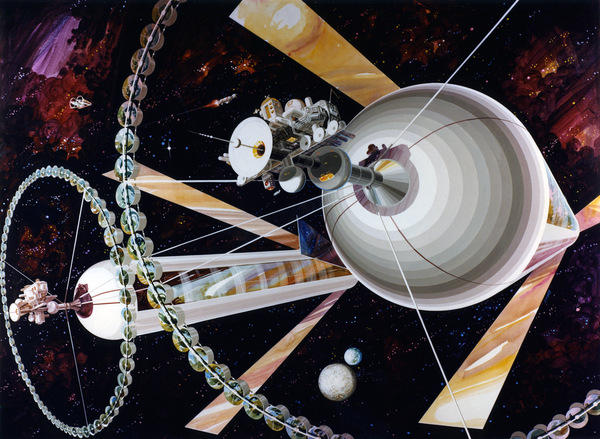This article asks: O’Neill Cylinders: A futuristic solution for long-term space colonization? Find out more about O’Neill cylinders and long-term space colonization.

As humanity’s interest in space exploration and colonization continues to grow, scientists and engineers are exploring various possibilities for long-term human habitation in space.
One of the most promising concepts is the O’Neill Cylinder, a massive artificial habitat designed to support a self-sustaining human colony in space.
With the potential to provide artificial gravity, ample living space, and sustainable resource utilization, O’Neill Cylinders could offer a futuristic solution to the challenges of long-term space colonization.
In this article, we’ll take a closer look at the concept of O’Neill Cylinders, exploring their design, capabilities, and potential for realizing humanity’s dreams of space exploration and colonization.
Can O’Neill Cylinders House A Colony In Space?
Yes, O’Neill cylinders can potentially house a colony in space. An O’Neill cylinder is a proposed space habitat concept that consists of a rotating cylinder-shaped space station.
While it is theoretically possible to house a colony in space within an O’Neill cylinder, it would require significant resources, technology, and planning to make it a reality.
- The interior surface of the cylinder would provide a living space for a large number of people, and it could simulate gravity through centrifugal force.
- The O’Neill cylinder would provide a closed environment that could support a self-sustaining colony in space.
- It could be designed to house living quarters, agricultural areas, manufacturing facilities, and other infrastructure necessary for a self-sufficient colony.
However, building an O’Neill cylinder and establishing a self-sufficient colony in space would be an enormous engineering and logistical challenge.
It would require a significant investment of resources and technology, as well as careful planning to ensure the sustainability of the colony.
How Would an O’Neill Cylinder Work?
An O’Neill cylinder is a proposed space habitat design that consists of a large, rotating cylinder-shaped space station. The concept was first introduced by physicist Gerard K. O’Neill in the 1970s as a potential solution for long-term human habitation in space.
The basic idea behind an O’Neill cylinder is to create an artificial environment that simulates gravity through the use of centrifugal force.
The cylinder would rotate around a central axis, and the centrifugal force generated by the rotation would create an outward force that would simulate gravity on the interior surface of the cylinder.
The interior of the cylinder would be divided into different sections, including living quarters, agricultural areas, manufacturing facilities, and other infrastructure necessary for a self-sustaining colony.
The sections would be arranged along the length of the cylinder, with living quarters and other areas located on the interior surface of the cylinder, and agricultural and manufacturing areas located on the outer surface of the cylinder.
To generate the necessary energy for the colony, solar panels or other energy sources could be located on the exterior of the cylinder. The rotation of the cylinder would also create a day-night cycle, with the interior of the cylinder experiencing a day and night cycle that simulates the natural cycle on Earth.
Overall, the O’Neill cylinder concept offers a potential solution for long-term human habitation in space, by creating an artificial environment that can support a self-sufficient colony.
Building such a habitat would be an enormous engineering and logistical challenge, requiring significant investment in resources and technology.
How Many People Can Fit In An O Neill Cylinder?
The exact number of people that can fit in an O’Neill cylinder would depend on the size of the cylinder, the design of the habitat, and the resources available to support the colony.
It is estimated that a large O’Neill cylinder with a radius of 5 miles (8 kilometers) and a length of 20 miles (32 kilometers) could potentially house a population of several million people.
The interior surface of the cylinder would be divided into different sections, including living quarters, agricultural areas, manufacturing facilities, and other infrastructure necessary for a self-sustaining colony.
The sections would be arranged along the length of the cylinder, with living quarters and other areas located on the interior surface of the cylinder, and agricultural and manufacturing areas located on the outer surface of the cylinder.
To support a population of several million people, the O’Neill cylinder would need to have a robust infrastructure that could provide food, water, and other resources necessary for human survival. The habitat would need to be designed to recycle and reuse resources as much as possible, to minimize waste and ensure sustainability.
Overall, the O’Neill cylinder concept offers a potential solution for long-term human habitation in space, but building such a habitat would be an enormous engineering and logistical challenge, requiring significant investment in resources and technology.
How Much Would An O Neill Cylinder Cost?
The cost of building an O’Neill cylinder would depend on many factors, including the size and complexity of the habitat, the materials and technologies used in its construction, and the cost of transporting materials and equipment to space.
It is difficult to estimate the exact cost of building an O’Neill cylinder, but it would likely require a significant investment of resources and technology. Some estimates suggest that the cost could be in the range of hundreds of billions to trillions of dollars.
One of the biggest costs associated with building an O’Neill cylinder would be launching the materials and equipment into space. This could be mitigated by using in-situ resources available on the Moon or asteroids, but this would require additional investment in technology and infrastructure.
In addition to the initial construction costs, maintaining and operating an O’Neill cylinder would also require significant resources and funding.
The habitat would need to be designed to be self-sustaining, with the ability to recycle and reuse resources as much as possible, but there would still be ongoing costs associated with maintaining the infrastructure and supporting the human population.
Overall, while the cost of building an O’Neill cylinder would be significant, it may be considered a worthwhile investment if it enables long-term human habitation in space and opens up new opportunities for space exploration and colonization.
What Would Life Be Like In An O’Neill Colony?
Life in an O’Neill Colony would be different from life on Earth in many ways, but it would also offer many unique opportunities and advantages. Here are some aspects of life in an O’Neill Colony:
Artificial gravity:
One of the most noticeable differences would be the artificial gravity created by the rotation of the cylinder, which would feel similar to gravity on Earth. This would make it possible to live and work in a more natural and comfortable environment than in microgravity.
Closed environment:
The O’Neill Colony would be a closed environment, with limited resources and waste management systems. The colony would need to be designed to be self-sustaining, with the ability to recycle and reuse resources as much as possible, to minimize waste and ensure sustainability.
Agriculture:
The outer surface of the cylinder could be used for agriculture, providing fresh produce and supporting the colony’s food needs. Vertical farming and hydroponics could be used to maximize the use of space and resources.
Manufacturing:
The O’Neill Colony would also have manufacturing facilities to produce goods and materials needed by the colony. The colony could potentially become a hub for space-based manufacturing and resource utilization.
Community life:
The O’Neill Colony would be a community of people working and living together. This would provide opportunities for social interaction, cultural exchange, and a sense of belonging.
Limited access to Earth:
Because the O’Neill Colony would be located in space, access to Earth would be limited. This would require the colony to be self-sufficient in terms of resources and infrastructure.
Overall, life in an O’Neill Colony would be a unique and challenging experience, but it would also offer opportunities for scientific discovery, technological innovation, and long-term human habitation in space.
References for “O’Neill Cylinders: A futuristic solution for long-term space colonization?”
“The High Frontier: Human Colonies in Space” by Gerard K. O’Neill – This is a classic book that introduced the concept of O’Neill cylinders in the 1970s.
“Colonies in Space” by T.A. Heppenheimer – This book provides a comprehensive analysis of the concept of space colonization, including the O’Neill cylinder.
“The Case for Mars” by Robert Zubrin – This book explores the possibilities of colonizing Mars, but also includes a discussion of O’Neill cylinders as an alternative option.
“Space Settlements: A Design Study” by NASA – This study, conducted in the 1970s, examines the design and engineering of space colonies, including O’Neill cylinders.
“Mining the Sky: Untold Riches from the Asteroids, Comets, and Planets” by John S. Lewis – This book examines the economic possibilities of space exploration and colonization, including the potential for O’Neill cylinders.
“The Millennial Project: Colonizing the Galaxy in Eight Easy Steps” by Marshall T. Savage – This book explores the possibilities of space colonization, including O’Neill cylinders, and outlines a plan for achieving it.
“Living Aloft: Human Requirements for Extended Spaceflight” by NASA – This report examines the challenges of long-term spaceflight and discusses the potential benefits of O’Neill cylinders for human habitation.
“A U.S. Space Program for Space Settlement” by Al Globus – This book provides a comprehensive overview of the engineering, design, and construction of space colonies, including O’Neill cylinders.
“Space Colonies: A Design Study” by NASA – This study, conducted in the 1970s, examines the design and engineering of space colonies, including O’Neill cylinders.
‘O’Neill Cylinders: A futuristic solution for long-term space colonization?’ is one important topic in our series exploring the role of O’Neill Cylinders in space colonization.
Read more about these topics by following the links below:
Republished by Blog Post Promoter
